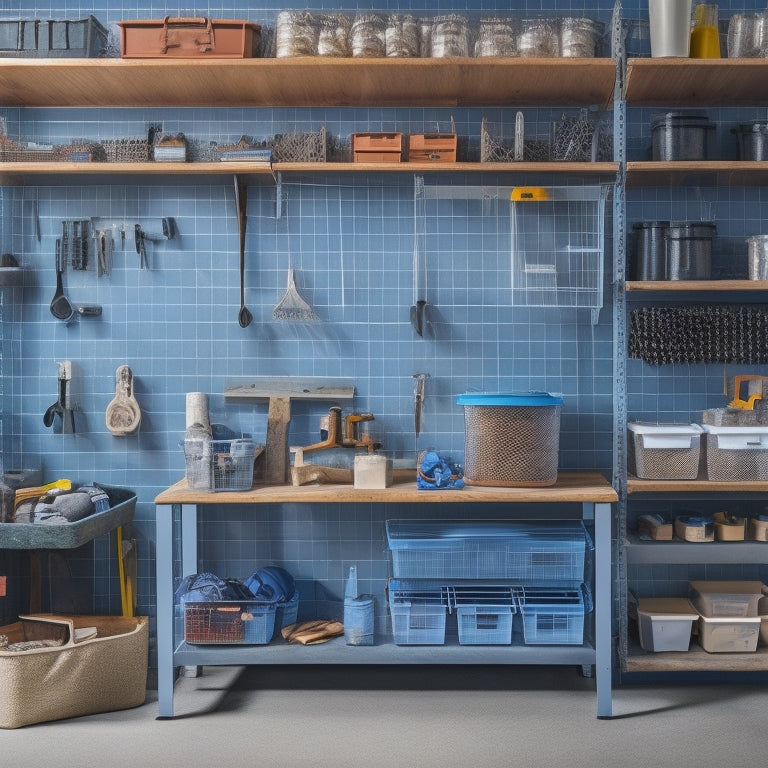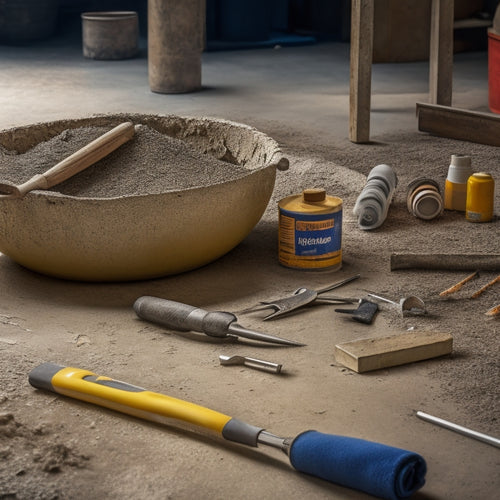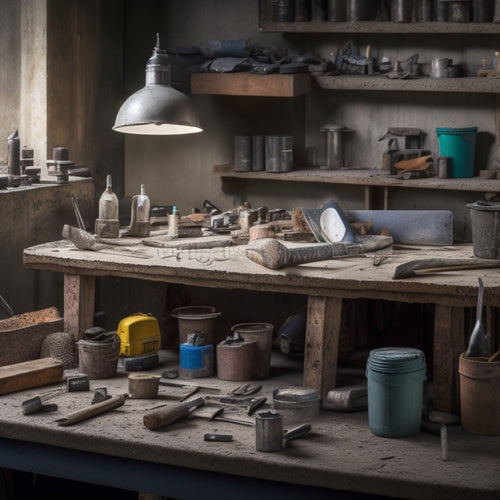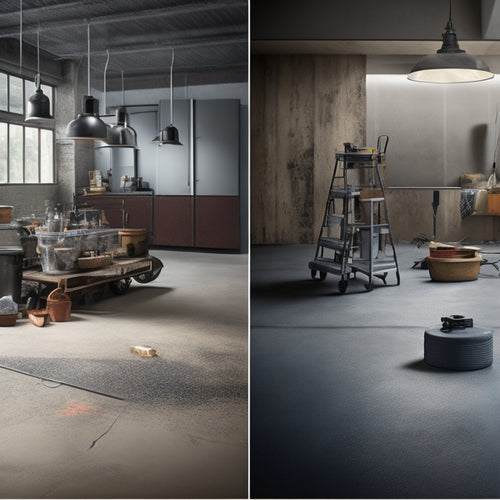
Budget-Friendly Storage Solutions for Concrete Repair Tools
Share
You can boost your productivity and reduce costs by implementing efficient and budget-friendly storage solutions for your concrete repair tools. Repurpose everyday items like muffin tins or use pegboards to organize small accessories, and designate a specific area for tools to enhance efficiency. Consider DIY shelving with labeled bins, compact toolboxes, or portable storage cases to keep tools organized and within reach. Optimize your workspace by utilizing vertical storage space and labeling tools for easy identification. By taking these steps, you'll be able to quickly locate the right equipment when you need it, and you'll discover even more ways to optimize your tool storage setup.
Key Takeaways
• Repurpose everyday items like muffin tins and buckets to organize small concrete repair tools and accessories on a budget.
• Utilize DIY shelving and pegboards to store tools, maintain accessibility, and prevent floor damage and tool corrosion.
• Invest in affordable and portable storage cases and toolboxes with wheels to improve organization, mobility, and productivity.
• Maximize vertical storage space by installing shelves, hooks, and wall-mounted racks to keep frequently used tools within easy reach.
• Implement labeling and organization systems to easily identify and track tools, reducing repair needs and enhancing efficiency.
Crack Filling Tool Storage Ideas
You can maximize your workshop's storage capacity by repurposing everyday items to store crack filling tools, such as using old muffin tins to organize small accessories like tips and nozzles.
This creative approach guarantees that your tools are easily accessible and within reach, saving you time and effort when performing crack sealing techniques. Furthermore, storing your tools properly helps maintain their condition, reducing the need for frequent repair tool maintenance.
Another idea is to utilize pegboards or hooks to hang your crack filling tools, keeping them off the floor and protected from damage. This also prevents tripping hazards, guaranteeing a safer working environment.
Consider designating a specific area for your crack filling tools, making it easier to locate the right tool when you need it. By implementing these storage ideas, you'll be able to work more efficiently and effectively, resulting in better outcomes for your concrete repair projects.
Repurposed Container Storage Hacks
By repurposing containers like empty buckets, crates, or boxes, you can create customized storage solutions that keep your crack filling tools and materials organized and within easy reach. This hack is not only budget-friendly but also environmentally friendly as you're reusing items that would otherwise end up in landfills.
Here are some creative ways to repurpose containers for storing concrete repair tools and materials:
| Container Type | Storage Idea | Benefits |
|---|---|---|
| Repurposed Buckets | Store small tools like trowels, scrapers, and chisels | Easy access, keeps tools organized, and prevents loss |
| Creative Jars | Store small materials like epoxy, sealants, or adhesives | Visibility, prevents spills, and keeps materials fresh |
| Plastic Crates | Store larger tools like drills, saws, or mixers | Protects tools from damage, keeps them organized, and saves space |
| Cardboard Boxes | Store consumables like sandpaper, gloves, or safety goggles | Easy labeling, keeps consumables organized, and saves space |
| Metal Containers | Store heavy materials like concrete, aggregate, or cement | Durable, protects materials from weather, and easy to clean |
DIY Shelving for Concrete Tools
Now that you've got your concrete tools, it's time to get them organized.
You'll need to reflect on how you'll store them in a way that makes sense for your workspace, which is where DIY shelving comes in.
You'll want to contemplate tool organization ideas, shelving material options, and space-saving designs to create a system that works best for you.
Tool Organization Ideas
Organizing your concrete tools efficiently can save you time and energy on the job site, and a DIY shelving system is an affordable way to achieve this. By creating a functional storage space, you can improve your tool inventory and reduce the risk of lost or damaged equipment.
Here are some tool organization ideas to get you started:
| Tool Category | Storage Tip |
|---|---|
| Hand Tools | Store in small bins or containers with labels for easy identification |
| Power Tools | Hang from pegboards or hooks to keep them off the floor and prevent damage |
| Consumables | Store in transparent bins or containers to monitor inventory levels |
When designing your DIY shelving system, consider the storage aesthetics. You want your tools to be easily accessible and visible, while also maintaining a clean and organized workspace. By implementing these tool organization ideas, you can create a safe and efficient storage space that meets your concrete repair needs.
Shelving Material Options
What type of shelving material will best support the weight and demands of your concrete tools and equipment? When it comes to DIY shelving for concrete tools, you have two primary options: plywood and metal. Both have their pros and cons, but ultimately, the choice depends on your specific needs and preferences.
Plywood shelving is a cost-effective option that's easy to install and can be customized to fit your space. However, it may not be as durable as metal shelving, especially when it comes to heavy tools and equipment.
Metal shelving, on the other hand, is more robust and can withstand the weight of your concrete tools. It's also easier to clean and maintain.
If you're planning to store your tools and equipment outdoors, consider using weather-resistant materials like galvanized metal or pressure-treated plywood. These materials can withstand harsh weather conditions and guarantee your tools remain safe and dry.
When choosing a shelving material, prioritize safety and durability to guarantee your tools are protected and easily accessible.
Space-Saving Designs
How can you maximize your storage space while keeping your concrete tools and equipment easily accessible? One effective way is to implement space-saving designs in your DIY shelving. By doing so, you'll be able to store more tools in a compact area, reducing clutter and increasing safety.
Consider using compact toolboxes that can be mounted on the wall or placed on shelves. These take up less space than traditional toolboxes and can be easily labeled for quick identification.
You can also use stackable bins and containers to store smaller items like drill bits, screws, and other fasteners. Label each bin so you can quickly find what you need.
Another efficient storage solution is to install a pegboard on your shelving unit. This allows you to hang tools like trowels, hammers, and levels, keeping them organized and within reach.
Budget-Friendly Toolbox Options
When it comes to budget-friendly toolbox options, you'll want to contemplate solutions that offer flexibility and convenience.
You can't go wrong with a toolbox on wheels, which allows you to easily move your tools around the job site or garage.
Alternatively, portable storage cases provide a compact and organized way to store your tools and supplies.
Toolbox on Wheels
You'll be rolling out of cluttered corners and into organized bliss with a toolbox on wheels, a budget-friendly solution that keeps your tools within easy reach. This mobile storage solution is designed to maximize your workspace, providing effortless access to your concrete repair tools.
When selecting a toolbox on wheels, consider the vital features you need. Look for a sturdy construction, rust-resistant materials, and a durable finish that can withstand the demands of your job site. Additionally, think about the toolbox features that matter most to you, such as compartments, trays, and dividers to keep your tools organized and protected.
Mobility considerations are also essential. Verify the toolbox has a sturdy handle and smooth-rolling wheels that can navigate rough terrain. You'll appreciate the convenience of being able to move your tools around the site with ease.
With a toolbox on wheels, you'll be more productive, efficient, and safe. You'll no longer have to worry about tripping hazards or wasting time searching for misplaced tools. By investing in a budget-friendly toolbox on wheels, you'll be well on your way to a more organized and efficient concrete repair operation.
Portable Storage Cases
Portable storage cases offer a compact and affordable alternative to traditional toolboxes, providing a convenient way to store and transport your concrete repair tools and accessories. As a concrete repair professional, you understand the importance of having your tools organized and within reach. Portable storage cases guarantee that your tools are protected from damage and corrosion, while also keeping them easily accessible.
When choosing a portable storage case, consider the following factors:
| Feature | Benefit |
|---|---|
| Water-resistant design | Protects tools from moisture and corrosion |
| Durable construction | Assures tool durability and longevity |
| Multiple compartments | Organizes tools and accessories for easy access |
| Portable designs | Allows for easy transportation to job sites |
| Affordable pricing | Fits within your budget |
With a portable storage case, you can rest assured that your tools are safe and secure, while also having the flexibility to take them wherever you need to go. By investing in a high-quality portable storage case, you're investing in the longevity of your tools and the success of your concrete repair business.
Utilizing Vertical Storage Space
Make the most of your walls by installing shelves, hooks, or storage units that maximize the often-wasted vertical space in your home or office. This is especially important when it comes to storing concrete repair tools, which can be bulky and heavy.
By utilizing wall-mounted racks, you can keep frequently used tools within easy reach, freeing up floor space for other essential items. Consider installing vertical bins or containers to store smaller items like drill bits, mixers, or other accessories. This won't only keep your workspace organized but also prevent tripping hazards and reduce the risk of accidental damage to your tools.
When choosing wall-mounted storage solutions, make certain they're sturdy and can support the weight of your tools. Look for products with a rust-resistant coating to prevent corrosion and extend their lifespan.
Additionally, consider the ease of installation and adjustability to accommodate different tool sizes and types. By optimizing your vertical space, you'll create a safer, more efficient workspace that allows you to focus on getting the job done.
Labeling and Organization Tips
Labeling and Organization Tips
Organize your storage space by assigning a designated spot for each tool and labeling it clearly, so you can quickly locate what you need and avoid wasting time searching for misplaced items. This will help you stay efficient and focused on the task at hand.
| Labeling Techniques | Organization Systems |
|---|---|
| Use brightly colored labels to categorize tools by type | Create a tool inventory list to track what you have |
| Label each tool with its name and expiration date | Designate a specific area for frequently used tools |
| Use pictures or icons to identify tools with similar functions | Implement a "first in, first out" system for consumable materials |
| Create a master list of all tools and their corresponding labels | Assign a specific tool to a specific job or task |
| Use a consistent labeling format throughout your storage space | Schedule regular inventory checks to maintain organization |
Adapting Old Furniture for Storage
Upcycling old furniture into storage solutions is a budget-friendly way to breathe new life into discarded items while decluttering your space. You can easily repurpose old furniture pieces to store your concrete repair tools, keeping them organized and within reach.
Consider transforming an old dresser into an upcycled cabinet with designated drawers for specific tools, or convert a vintage crate into a storage bin for smaller items like drill bits and screws.
When adapting old furniture for storage, prioritize safety by ensuring the piece is sturdy and secure. You don't want it to topple over and cause injury or damage.
Also, make sure the storage solutions you create are easily accessible and won't put you at risk of straining your back or shoulders.
With a little creativity and some basic DIY skills, you can create functional storage solutions that not only save you money but also give your workspace a unique, personalized touch.
Frequently Asked Questions
Can I Store Concrete Tools in a Humid Environment?
You're wondering if you can store concrete tools in a humid environment. The short answer is, it's not ideal.
High humidity can lead to rust and corrosion, damaging your tools.
To prevent this, make sure to dry your tools thoroughly after use and store them in a well-ventilated area or consider using rust-preventing coatings or storage containers.
This will help minimize the humidity effects and keep your tools in good condition.
How Often Should I Clean My Concrete Repair Tool Storage?
You'll want to clean your concrete repair tool storage regularly to prevent damage and guarantee safety. Aim to clean your storage at least every 2-3 months, or more often if you notice dirt and grime building up.
Good storage organization is key - keep similar tools together, label everything, and store them in a dry, well-ventilated area. This will make cleaning a breeze and help you stay on top of maintenance.
Are Plastic Storage Bins Suitable for Heavy Tools?
You're exploring a treasure trove of storage options, but will plastic bins be the treasure that holds your heavy tools? Not always.
You need to evaluate the storage weight capacity, ensuring it can handle the bulk of your concrete repair tools. Look for bins with sturdy handles and a robust design.
For tool organization tips, label each bin and store tools by category to prevent a heavy tool from crushing a lighter one.
Can I Store Concrete Tools in a Non-Climate-Controlled Garage?
You're wondering if you can store concrete tools in a non-climate-controlled garage. The answer is yes, but with caution.
Rust prevention is key, so make sure to clean and dry your tools before storing them. Use rust-inhibiting coatings or sprays to protect metal tools.
For tool organization, consider using bins, hooks, or shelves that allow airflow and won't trap moisture. This will help prevent rust and keep your tools in good condition.
Do I Need to Lubricate Tool Hinges Before Storage?
Before storing your concrete repair tools, you should definitely lubricate the tool hinges.
This essential step of tool maintenance guarantees hinge care, preventing rust and corrosion that can render your tools useless.
Apply a few drops of lubricant, like silicone spray or oil, to the hinges to keep them running smoothly.
This simple habit will save you time and money in the long run, and make sure your tools are ready for the next project.
Conclusion
As you tidy up your concrete repair tools, imagine a workspace transformed into a well-oiled machine, where every tool has its designated spot, and productivity soars.
With these budget-friendly storage solutions, you've tamed the chaos, and your tools are now at your fingertips, ready to tackle the next project.
Like a master builder, you've constructed a system that's sturdy, efficient, and easy to maintain.
Your workspace is now a reflection of your expertise, a symphony of organization and precision.
Related Posts
-

Top Tools for Repairing Cracked Concrete Surfaces
When tackling a cracked concrete surface repair, you'll need the right tools to guarantee a durable fix. Start with e...
-

Top Tools for Concrete Repair Success
When it comes to concrete repair success, you'll need a well-stocked toolkit with essential hand tools like trowels, ...
-

Top Tools for Revamping Old Concrete Floors
You'll need a range of tools to revamp your old concrete floor, starting with epoxy, acrylic, or polyurethane paint, ...


